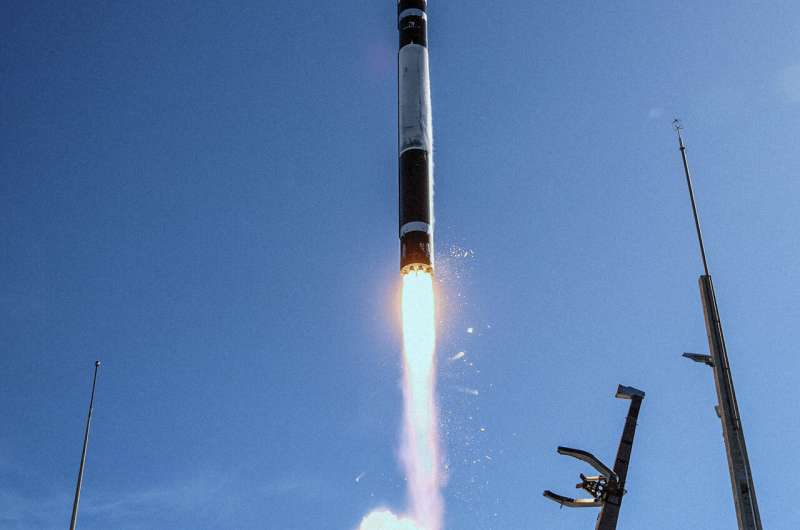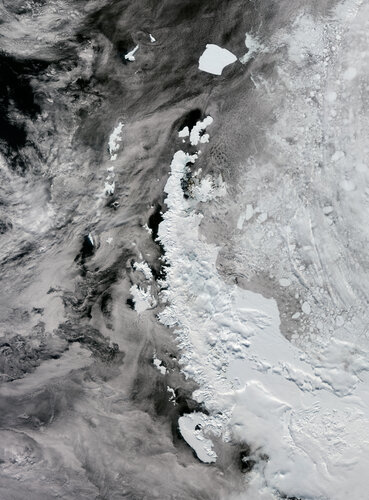
Copernical Team
Friday, 15 December 2023 08:14
Rocket Lab launches a Japanese satellite from the space company's complex in New Zealand

California-based Rocket Lab, which specializes in putting small satellites into orbit, launched a Japanese satellite on Friday from the space company's complex on New Zealand's Mahia Peninsula.
Published in
News
Tagged under
Friday, 15 December 2023 08:15
Biden hosts four NASA astronauts, the first crew aiming to fly around the moon in a half-century

The four astronauts assigned to fly around the moon for the first time in 50 years met with President Joe Biden on Thursday at the White House, where he showed off an moon rock on display in the Oval Office that was collected in the Apollo era.
Published in
News
Tagged under
Friday, 15 December 2023 08:00
Earth from Space: Icy landscape
 Image:
As the holiday season swiftly approaches, frosty landscapes tend to be associated with the magical idea of a white Christmas. But this Copernicus Sentinel-3 image over the Antarctica Peninsula sheds light on a different perspective.
Image:
As the holiday season swiftly approaches, frosty landscapes tend to be associated with the magical idea of a white Christmas. But this Copernicus Sentinel-3 image over the Antarctica Peninsula sheds light on a different perspective.
Published in
News
Tagged under
Friday, 15 December 2023 09:09
China's space programme: Five things to know
Beijing (AFP) Dec 14, 2023
 When Chang'e-3 became the first Chinese craft to land on the Moon 10 years ago, it kicked off nationwide celebrations - and a decade of major successes for a rapidly accelerating space programme.
Since the December 14, 2013 landing, China has built a crewed space station, sent a robotic rover to Mars and become the first nation to make a controlled landing on the far side of the Moon.
P
When Chang'e-3 became the first Chinese craft to land on the Moon 10 years ago, it kicked off nationwide celebrations - and a decade of major successes for a rapidly accelerating space programme.
Since the December 14, 2013 landing, China has built a crewed space station, sent a robotic rover to Mars and become the first nation to make a controlled landing on the far side of the Moon.
P
 When Chang'e-3 became the first Chinese craft to land on the Moon 10 years ago, it kicked off nationwide celebrations - and a decade of major successes for a rapidly accelerating space programme.
Since the December 14, 2013 landing, China has built a crewed space station, sent a robotic rover to Mars and become the first nation to make a controlled landing on the far side of the Moon.
P
When Chang'e-3 became the first Chinese craft to land on the Moon 10 years ago, it kicked off nationwide celebrations - and a decade of major successes for a rapidly accelerating space programme.
Since the December 14, 2013 landing, China has built a crewed space station, sent a robotic rover to Mars and become the first nation to make a controlled landing on the far side of the Moon.
P
Published in
News
Tagged under
Friday, 15 December 2023 09:09
Satellite-based method measures carbon in peat bogs
Boston MA (SPX) Dec 14, 2023
 Peat bogs in the tropics store vast amounts of carbon, but logging, plantations, road building, and other activities have destroyed large swaths of these ecosystems in places like Indonesia and Malaysia. Peat formations are essentially permanently flooded forestland, where dead leaves and branches accumulate because the water table prevents their decomposition.
The pileup of organic materi
Peat bogs in the tropics store vast amounts of carbon, but logging, plantations, road building, and other activities have destroyed large swaths of these ecosystems in places like Indonesia and Malaysia. Peat formations are essentially permanently flooded forestland, where dead leaves and branches accumulate because the water table prevents their decomposition.
The pileup of organic materi
 Peat bogs in the tropics store vast amounts of carbon, but logging, plantations, road building, and other activities have destroyed large swaths of these ecosystems in places like Indonesia and Malaysia. Peat formations are essentially permanently flooded forestland, where dead leaves and branches accumulate because the water table prevents their decomposition.
The pileup of organic materi
Peat bogs in the tropics store vast amounts of carbon, but logging, plantations, road building, and other activities have destroyed large swaths of these ecosystems in places like Indonesia and Malaysia. Peat formations are essentially permanently flooded forestland, where dead leaves and branches accumulate because the water table prevents their decomposition.
The pileup of organic materi
Published in
News
Tagged under
Friday, 15 December 2023 09:09
Chinese scientists build largest-ever neutral hydrogen catalog in deep space
Beijing, China (SPX) Dec 14, 2023
 Using the Five-hundred-meter Aperture Spherical Radio Telescope, or the "China Sky Eye," a team of Chinese astronomers built the largest-ever high-quality catalog of neutral hydrogen (HI) sources beyond our Galaxy.
Hydrogen, the most abundant element in the universe, is a key component of galaxies. Within disk galaxies, the HI is a significant component of the interstellar medium.
Th
Using the Five-hundred-meter Aperture Spherical Radio Telescope, or the "China Sky Eye," a team of Chinese astronomers built the largest-ever high-quality catalog of neutral hydrogen (HI) sources beyond our Galaxy.
Hydrogen, the most abundant element in the universe, is a key component of galaxies. Within disk galaxies, the HI is a significant component of the interstellar medium.
Th
 Using the Five-hundred-meter Aperture Spherical Radio Telescope, or the "China Sky Eye," a team of Chinese astronomers built the largest-ever high-quality catalog of neutral hydrogen (HI) sources beyond our Galaxy.
Hydrogen, the most abundant element in the universe, is a key component of galaxies. Within disk galaxies, the HI is a significant component of the interstellar medium.
Th
Using the Five-hundred-meter Aperture Spherical Radio Telescope, or the "China Sky Eye," a team of Chinese astronomers built the largest-ever high-quality catalog of neutral hydrogen (HI) sources beyond our Galaxy.
Hydrogen, the most abundant element in the universe, is a key component of galaxies. Within disk galaxies, the HI is a significant component of the interstellar medium.
Th
Published in
News
Tagged under
Friday, 15 December 2023 09:09
Design the patch for Hera's Milani CubeSat
Paris (ESA) Dec 14, 2023
 Milani needs you! This is your chance to design a mission patch for the Milani CubeSat which will fly with ESA's Hera planetary defence spacecraft to the Didymos binary asteroid system.
ESA is offering graphic designers and artists a unique opportunity to feature their work on the Milani CubeSat's mission patch. This competition is an exciting opportunity for students of graphic art or des
Milani needs you! This is your chance to design a mission patch for the Milani CubeSat which will fly with ESA's Hera planetary defence spacecraft to the Didymos binary asteroid system.
ESA is offering graphic designers and artists a unique opportunity to feature their work on the Milani CubeSat's mission patch. This competition is an exciting opportunity for students of graphic art or des
 Milani needs you! This is your chance to design a mission patch for the Milani CubeSat which will fly with ESA's Hera planetary defence spacecraft to the Didymos binary asteroid system.
ESA is offering graphic designers and artists a unique opportunity to feature their work on the Milani CubeSat's mission patch. This competition is an exciting opportunity for students of graphic art or des
Milani needs you! This is your chance to design a mission patch for the Milani CubeSat which will fly with ESA's Hera planetary defence spacecraft to the Didymos binary asteroid system.
ESA is offering graphic designers and artists a unique opportunity to feature their work on the Milani CubeSat's mission patch. This competition is an exciting opportunity for students of graphic art or des
Published in
News
Tagged under
Friday, 15 December 2023 09:09
Some Icy Exoplanets May Have Habitable Oceans and Geysers
Pasadena CA (JPL) Dec 14, 2023
 A NASA study expands the search for life beyond our solar system by indicating that 17 exoplanets (worlds outside our solar system) could have oceans of liquid water, an essential ingredient for life, beneath icy shells. Water from these oceans could occasionally erupt through the ice crust as geysers. The science team calculated the amount of geyser activity on these exoplanets, the first time
A NASA study expands the search for life beyond our solar system by indicating that 17 exoplanets (worlds outside our solar system) could have oceans of liquid water, an essential ingredient for life, beneath icy shells. Water from these oceans could occasionally erupt through the ice crust as geysers. The science team calculated the amount of geyser activity on these exoplanets, the first time
 A NASA study expands the search for life beyond our solar system by indicating that 17 exoplanets (worlds outside our solar system) could have oceans of liquid water, an essential ingredient for life, beneath icy shells. Water from these oceans could occasionally erupt through the ice crust as geysers. The science team calculated the amount of geyser activity on these exoplanets, the first time
A NASA study expands the search for life beyond our solar system by indicating that 17 exoplanets (worlds outside our solar system) could have oceans of liquid water, an essential ingredient for life, beneath icy shells. Water from these oceans could occasionally erupt through the ice crust as geysers. The science team calculated the amount of geyser activity on these exoplanets, the first time
Published in
News
Tagged under
Friday, 15 December 2023 09:09
NEOWISE space telescope marks 10 Years on orbit as End of Mission looms
Pasadena CA (JPL) Dec 14, 2023
 NASA's NEOWISE has had a busy decade. Since its reactivated mission began on Dec. 13, 2013, the space telescope has discovered a once-in-a-lifetime comet, observed more than 3,000 near-Earth objects, bolstered international planetary defense strategies, and supported another NASA mission's rendezvous with a distant asteroid. And that's just a partial list of accomplishments.
But all good t
NASA's NEOWISE has had a busy decade. Since its reactivated mission began on Dec. 13, 2013, the space telescope has discovered a once-in-a-lifetime comet, observed more than 3,000 near-Earth objects, bolstered international planetary defense strategies, and supported another NASA mission's rendezvous with a distant asteroid. And that's just a partial list of accomplishments.
But all good t
 NASA's NEOWISE has had a busy decade. Since its reactivated mission began on Dec. 13, 2013, the space telescope has discovered a once-in-a-lifetime comet, observed more than 3,000 near-Earth objects, bolstered international planetary defense strategies, and supported another NASA mission's rendezvous with a distant asteroid. And that's just a partial list of accomplishments.
But all good t
NASA's NEOWISE has had a busy decade. Since its reactivated mission began on Dec. 13, 2013, the space telescope has discovered a once-in-a-lifetime comet, observed more than 3,000 near-Earth objects, bolstered international planetary defense strategies, and supported another NASA mission's rendezvous with a distant asteroid. And that's just a partial list of accomplishments.
But all good t
Published in
News
Tagged under


 Image:
Dragon rider
Image:
Dragon rider